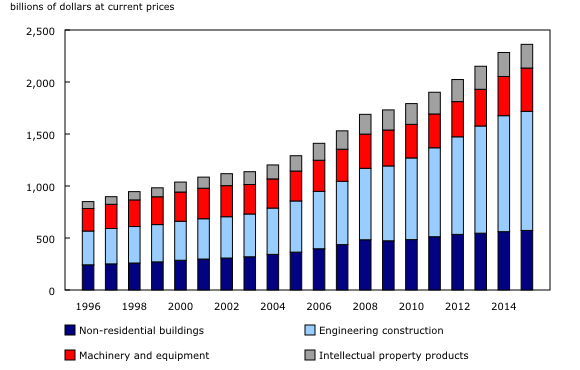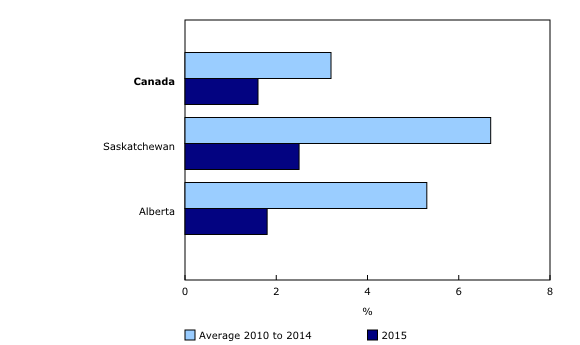Stock and consumption of fixed capital, 2015
Archived Content
Information identified as archived is provided for reference, research or recordkeeping purposes. It is not subject to the Government of Canada Web Standards and has not been altered or updated since it was archived. Please "contact us" to request a format other than those available.
Released: 2016-11-18
The volume of Canada's non-residential and residential net capital stock increased 2.2% from 2014. In value, the Canadian net capital stock reached $4.5 trillion in 2015, with non-residential capital stock accounting for 52.8% and residential capital stock representing the remaining 47.2%.
Non-residential capital stock
Non-residential capital stock, which is composed of building and engineering construction, machinery and equipment as well as intellectual property products, was 1.6% higher in 2015 than in 2014. The stock of non-residential engineering construction rose 3.3% following a 5.8% gain in 2014, while the stock of non-residential building construction increased by 1.1%, and machinery and equipment was up by 0.1%.
The stock of intellectual property products fell 1.9% in 2015, primarily driven by a decrease in mineral exploration and evaluation.
When calculating capital stock, a decrease in the stock occurs when the amount of depreciation exceeds the flow of new investment.
The non-residential capital stock rose in seven provinces and two territories. Newfoundland and Labrador had the strongest growth at 9.3%, the result of an increase in non-residential engineering and machinery and equipment, followed by Manitoba (+4.2%), Nunavut (+2.7%) and Saskatchewan (+2.5%). The capital stock decreased in Nova Scotia, Prince Edward Island, New Brunswick and Yukon.
Slowdown in capital stock expansion in oil-producing provinces
Alberta and Saskatchewan recorded decelerations in their capital stock expansion in 2015, the result of lower investments in the oil and gas extraction sector. Saskatchewan (+2.5%) and Alberta (+1.8%) each posted increases in their non-residential stock in 2015, compared with averages over the previous five years of 6.7% for Saskatchewan and 5.3% for Alberta.
While Alberta's share of Canada's gross domestic product was 16.4% in 2015, it accounted for 31.3% of the total non-residential stock in Canada, a slight decrease compared with 2014 (31.6%). In 2010, Alberta surpassed Ontario as the province with the largest share of Canada's non-residential stock, primarily as a result of increases in the mining, quarrying and oil and gas extraction industries.
In five provinces and territories, more than one-third of non-residential capital stock was held by the government sector. However, in three provinces and two territories, capital stock was highly concentrated in the mining, quarrying and oil and gas extraction industries. In 2015, these industries accounted for 69.7% of the capital stock in the Northwest Territories, 65.4% in Nunavut, 62.0% in Alberta, 50.3% in Newfoundland and Labrador and 48.3% in Saskatchewan.
Nationally, mining, quarrying, and oil and gas extraction industries accounted for 29.5% of non-residential capital stock, while the government sector accounted for 23.9%.
Residential capital stock
Residential capital stock, which consists of new residential construction, renovations to existing structures and transfer costs, rose 2.9% in 2015, slightly lower than the previous year (+3.0%). Overall, the residential capital stock reached $2.1 trillion in 2015. Over two-thirds was the result of the investment in home construction, while the remaining third was the result of renovations on existing residential structures.
With the exception of Nunavut, every province and territory posted a gain in 2015, led by Alberta (+4.3%), British Columbia (+4.2%) and Northwest Territories (+3.2%). Residential stock in Nunavut was the same as in 2014, the first time that territory reported no growth in this type of stock.
Note to readers
This release reflects revised estimates of investment flows and prices in accordance with the latest revision of the Canadian System of Macroeconomic Accounts.
The classification of non-residential capital stock is based on the final demand classification used in supply and use tables.
Estimates of non-residential and residential investment, depreciation and the associated net stocks are available by geographical breakdown on a current price basis, 2007 constant price basis (2007 asset price = 100) and chained (2007) dollar basis. Non-residential estimates of depreciation and stocks are available by industry and by asset, using linear, geometric and hyperbolic methods. Residential estimates are available by type of investment using geometric methods.
Contact information
For more information, or to enquire about the concepts, methods or data quality of this release, contact us (toll-free 1-800-263-1136; 514-283-8300; STATCAN.infostats-infostats.STATCAN@canada.ca) or Media Relations (613-951-4636; STATCAN.mediahotline-ligneinfomedias.STATCAN@canada.ca).
- Date modified:




